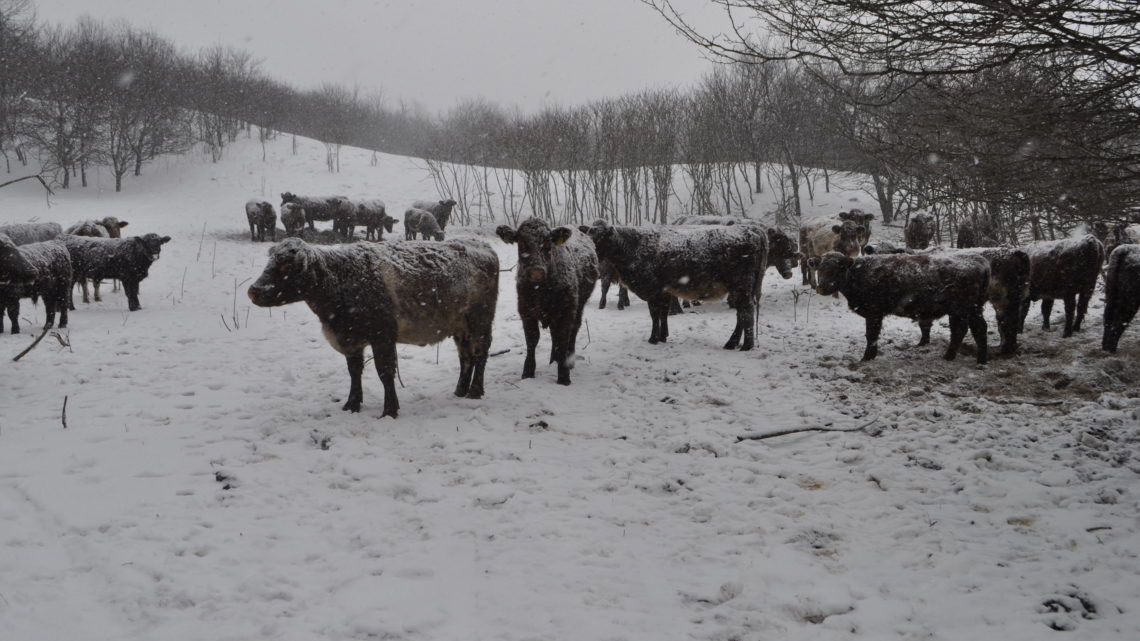2015 in Review

2015 was a great year at Banbury Grasslands, and we thought we’d share some highlights
It’s ‘almost’ hard to remember given our green Christmas and relatively mild winter weather that last January and February were so bitterly cold! The cattle spent most of their time outside bale grazing and generally only went indoors during the worst of the storms. We had a few frozen water lines, but were able to manage well.
In the spring, we had 14 calves born at Banbury Grasslands. Only two first-calf heifers received assistance since I saw them being born and they needed a bit of help. The rest I saw for the first time as lovely new calves – either learning to walk, being licked off by momma, or nursing. Calving season truly is a wonderful time of year! All female calves will join the cow herd as we expand and our grasslands continue to produce more grass each year under our management.
I eagerly anticipated grazing my eastern gamagrass for the first time last summer. Gamagrass is a warm season grass native to North America that thrived along side the enormous buffalo herds long ago. It grows really well during July and August loving the heat with its very deep roots. It is nicknamed ice-cream grass owing to its sweetness (high energy) and the fact that cattle will kill it by overgrazing unless they are forced to keep moving and allow it to recover (electric fence in our case or predators in the case of the buffalo). I planted it in 2013 after working through the import permits to get the seed in from the USA. I could have grazed it a bit in 2014, but opted to let the plants develop and grow deeper roots. Gamagrass can easily grow as tall as your shoulder and form big bunches. Now that the grass is well established, it should last a life-time with proper grazing management.
We harvested 18 head this year. They were mostly 22-28 month old steers who were born at my parents’ farm in Brighton in 2013 and moved to Banbury Grasslands after weaning. Due to a great year, we were able to donate an entire grass-fed animal to the Waterloo Region Foodbank.
In the fall, we tried something new – making apple cider. We collected the wild apples and brought them to a cider mill. We’ve been enjoying hot spiced apple cider this winter. Since I feed the cattle apple cider vinegar in their water (1%-2% by volume) and we had lots of apples, I decided to do another bulk batch of 430 litres and ferment it myself. Some of you may have seen this bubbling away in the shed when picking up meat orders. Apple cider vinegar is a natural immune boosting tonic and stimulates the rumen microbes to improve digestion.
As winter returned, we went back to bale grazing – this time on the ridge. For the previous two years, we bale grazed in the fields by the house and have seen dramatic grasslands improvement resulting from the manure and wasted hay building soil fertility. We are looking forward to seeing the change in the ridge this spring.
For the second year, we also raised meat chickens on pasture, and I think I’m getting the hang of it 🙂 The chickens certainly love it when I move their pens forward each day, pecking at the new grass, scratching the new ground and chasing bugs. We’ll do it again in 2016.
On a personal note, the family and I managed to get away for a camping trip as well an extended visit to Manitoba. Many thanks to Ernie, Alex and Teresa for checking in on the cattle and moving them to new grass each day we were away.
Thank you for your support in 2015 as we strove to produce high quality 100% grass-fed beef raised in an environmentally sustainable and friendly manner. We look forward to another great year and wish you the best in 2016!
David & Leslie
